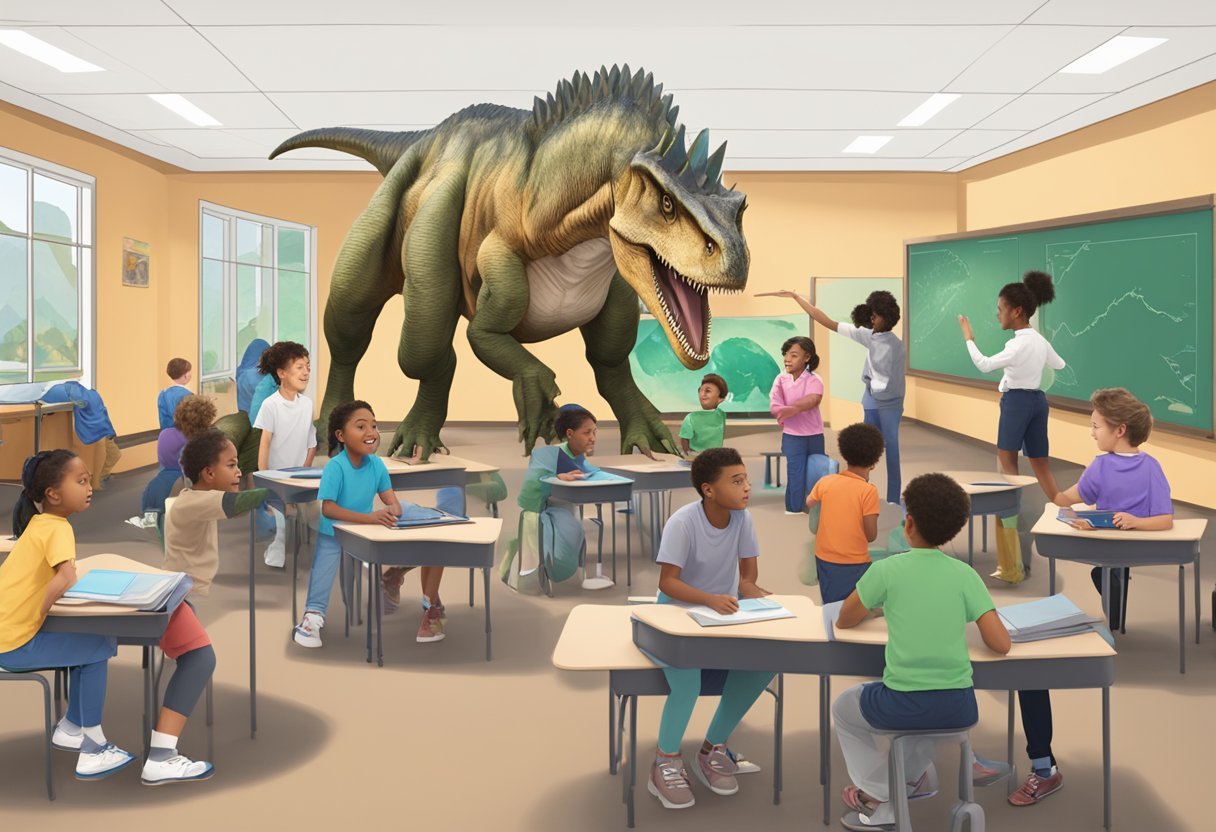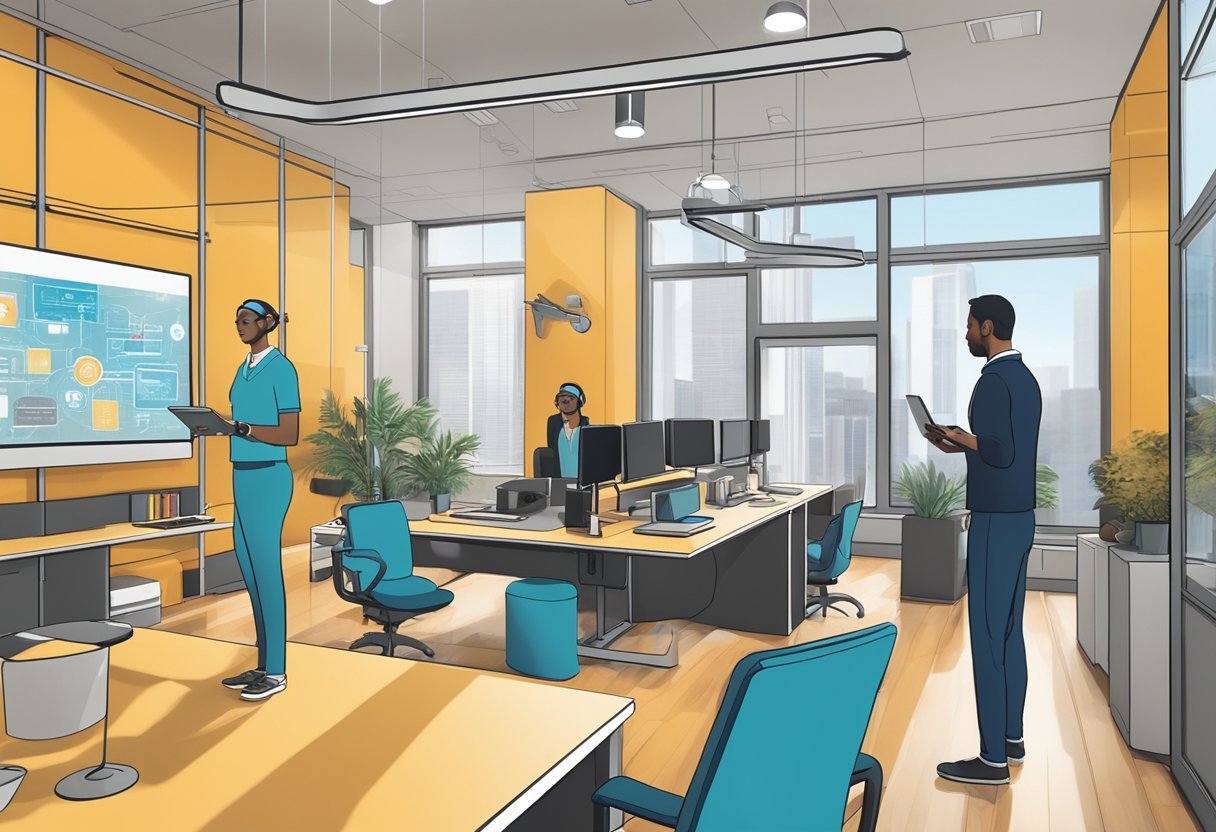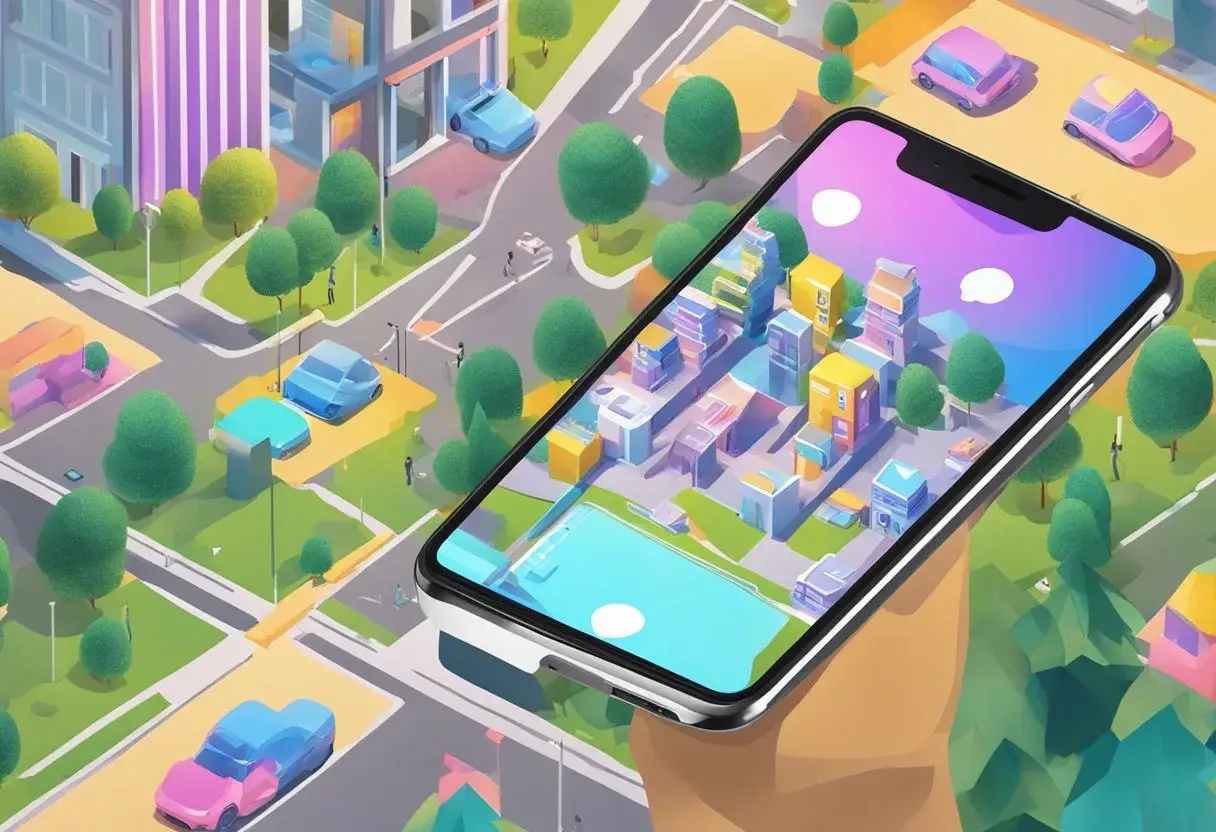Augmented reality (AR) is a technology that overlays digital elements onto real-world objects to enhance what users see and experience in the world around them. AR has been gaining popularity in education, as it can provide students with a unique and engaging way to learn. In this article, I will share with you 15 examples of augmented reality in education and how you can start these examples with your students.
Foundations of Augmented Reality in Education AR can be used in various educational settings such as science, math, art, and more. It can help students visualize complex concepts and ideas, making them easier to understand. AR can also provide students with opportunities to explore and interact with virtual objects, which can enhance their understanding of real-world objects. AR can help students develop problem-solving skills and critical thinking abilities.
Implementing AR in Learning Environments Implementing AR in learning environments can be challenging, but it can also be rewarding. Teachers need to have access to the right tools and resources to create AR experiences that are engaging and effective. They also need to be trained on how to use AR technology and integrate it into their curriculum.
Curriculum Enhancement Through AR AR can be used to enhance the curriculum in various ways. For example, in science classes, AR can be used to help students visualize complex concepts such as the human body or the solar system. In history classes, AR can be used to bring historical events to life, allowing students to experience them in a more immersive way. In art classes, AR can be used to help students create digital art and explore different artistic styles.
Key Takeaways
- AR is a technology that overlays digital elements onto real-world objects to enhance what users see and experience in the world around them.
- AR can be used in various educational settings such as science, math, art, and more to help students visualize complex concepts and ideas.
- Implementing AR in learning environments can be challenging, but it can also be rewarding, and AR can be used to enhance the curriculum in various ways.
Foundations of Augmented Reality in Education
Augmented Reality (AR) is a concept that involves the integration of digital information with the real world. It is a technology that overlays digital information onto the physical world, enhancing it in real-time. AR is different from Virtual Reality (VR), which creates a completely immersive digital environment. AR can be experienced through mobile devices, smart glasses, and other wearable technology.
AR technology has enormous potential in the education industry. It can enhance learning and make it more interactive and engaging. AR in education can provide students with a unique and personalized learning experience. It can help students understand complex concepts and visualize abstract ideas.
History and Evolution in Educational Contexts
AR technology has been around for decades, but it has only recently gained popularity in the education industry. In the past, AR was primarily used in the military, entertainment, and advertising industries. However, with the advancement of technology, AR has become more accessible and affordable.
AR technology has been used in various educational contexts, including museums, zoos, and science centers. It has been used to enhance the learning experience by providing students with interactive and immersive experiences. AR technology has also been used to provide students with virtual field trips, allowing them to explore different parts of the world without leaving the classroom.
Some of the early examples of AR in education include the AR Sandbox, which was developed by the University of California, Davis, and the AR Museum, which was developed by the Smithsonian American Art Museum. These early examples paved the way for the development of more sophisticated AR technology that can be used in various educational contexts.
AR technology is constantly evolving, and its potential in the education industry is enormous. As the technology becomes more accessible and affordable, we can expect to see more innovative uses of AR in education in the future.
15 Examples Of Augmented Reality In Education
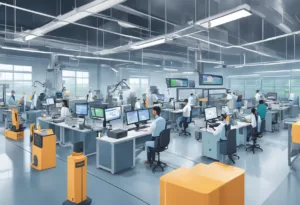
- AR textbooks and learning materials
- Interactive AR classroom lessons
- AR for anatomy and biology education
- Augmented reality field trips
- AR in chemistry and physics experiments
- Language learning with AR
- AR historical recreations
- AR for special education
- AR in astronomy and space education
- AR-enhanced flashcards and study aids
- AR for geography and geology
- AR in art and design education
- AR for vocational training
- AR in mathematics visualization
- AR environmental science simulations
AR Textbooks and Learning Materials
AR textbooks and learning materials are prime examples of augmented reality in education, where traditional books are enhanced with interactive, three-dimensional content. Students can scan images or pages with their mobile devices to bring up AR models that they can manipulate and explore. This not only makes learning more engaging but also helps in visualizing complex concepts that are difficult to grasp through static images. AR textbooks are particularly useful in subjects such as science, where three-dimensional structures play a key role in understanding.
Interactive AR Classroom Lessons
Interactive AR classroom lessons utilize augmented reality to create immersive learning experiences. Educators can project AR content onto classroom surfaces, allowing students to interact with the lesson in real-time. For instance, a history lesson could be brought to life with virtual historical figures or artifacts that students can examine up close. This use of AR makes classes more dynamic and can cater to different learning styles, keeping students engaged and improving retention.
AR for Anatomy and Biology Education
AR for anatomy and biology education is one of the most effective examples of augmented reality in education. It allows students to explore the human body or various biological processes in a highly detailed and interactive manner. With AR, learners can dissect layers of the human body, observe the functions of different organs, and even simulate biological processes, providing a deeper understanding of life sciences.
Augmented Reality Field Trips
Augmented reality field trips are an innovative way to bring the outside world into the classroom. Students can visit distant locations, historical sites, or even other planets without leaving their seats. This application of AR in education breaks down geographical barriers and provides all students with access to experiences that would otherwise be impossible due to cost or distance.
AR in Chemistry and Physics Experiments
AR in chemistry and physics experiments offers a safe and interactive way for students to engage with potentially dangerous or complex experiments. Through AR, learners can simulate chemical reactions, explore physics principles, and conduct virtual experiments that mimic the real thing. This not only keeps students safe but also allows for repeated trials without the expense of physical materials.
Language Learning with AR
Language learning with AR introduces an interactive component to mastering a new language. Augmented reality can overlay translations and pronunciations over objects in the real world, helping students to learn vocabulary and grammar in context. This method of language instruction can make learning more natural and intuitive, closely mimicking the way we learn our first language.
AR Historical Recreations
AR historical recreations are a captivating example of augmented reality in education, where students can experience historical events or explore ancient civilizations through immersive simulations. This technology can bring history books to life, allowing learners to visualize and interact with historical content, making it more tangible and memorable.
AR for Special Education
AR for special education provides personalized learning experiences for students with special needs. Augmented reality can be tailored to individual learning styles and abilities, offering a range of sensory inputs to help students with disabilities grasp educational content more effectively. This adaptive use of technology ensures that all students have equal opportunities to learn and succeed.
AR in Astronomy and Space Education
AR in astronomy and space education allows students to explore the cosmos in a virtual environment. They can interact with planets, stars, and galaxies, gaining a better understanding of the scale and composition of the universe. This application of AR makes abstract astronomical concepts more concrete and accessible.
AR-enhanced Flashcards and Study Aids
AR-enhanced flashcards and study aids take traditional study methods to the next level. By scanning flashcards with an AR app, students can see additional information or 3D models that help reinforce learning. This method is particularly useful for subjects that require memorization and recall, such as language vocabulary or medical terminology.
AR for Geography and Geology
AR for geography and geology enables students to interact with topographical maps and geological formations in three dimensions. This hands-on approach to learning helps students understand the physical aspects of the Earth’s surface, climate zones, and the processes that shape our planet, providing a more engaging way to learn about our world.
AR in Art and Design Education
AR in art and design education offers a new avenue for creative expression and learning. Students can view and create art that interacts with the real world, study design principles in a three-dimensional space, and even see how their work would look in a real-world context. This blend of technology and creativity opens up new possibilities for art and design instruction.
AR for Vocational Training
AR for vocational training is a practical application of augmented reality in education. It provides trainees with a realistic and interactive environment to practice skills, from automotive repair to surgical procedures. AR can guide users through complex tasks step-by-step, reducing the learning curve and preparing them for real-world applications.
AR in Mathematics Visualization
AR in mathematics visualization helps students understand abstract mathematical concepts by bringing them into the three-dimensional space. Complex equations and geometrical shapes can be visualized and manipulated, making it easier for learners to grasp difficult topics and engage with the material in a more intuitive way.
AR Environmental Science Simulations
AR environmental science simulations allow students to observe and interact with ecosystems, weather patterns, and environmental changes. This dynamic approach to learning can illustrate the impact of human activities on the environment and promote a better understanding of sustainability and conservation efforts. By simulating real-world scenarios, AR can foster a deeper appreciation and awareness of environmental science topics.
Implementing AR in Learning Environments
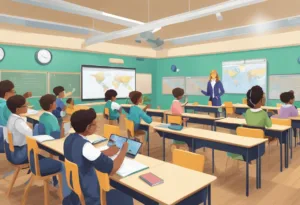
Augmented Reality (AR) is a technology that overlays digital information onto the real world. AR has the potential to transform traditional classrooms into interactive and engaging learning environments. This section explores how AR can be implemented in learning environments, including interactive classroom applications and AR as a teaching tool.
Interactive Classroom Applications
AR can be used to create interactive learning experiences in the classroom. Interactive applications can help students visualize complex concepts and make learning more engaging. For example, teachers can use AR to create interactive models of the human body, solar system, and other complex systems. Students can use their smartphones or tablets to explore and interact with these models in real-time.
AR can also be used to create interactive quizzes and games. Teachers can use AR to create scavenger hunts, quizzes, and other interactive activities that students can complete using their smartphones or tablets. This approach can make learning more fun and engaging for students.
Augmented Reality as a Teaching Tool
AR can also be used as a teaching tool to enhance traditional teaching methods. For example, teachers can use AR to provide students with additional resources and tools to help them learn. Teachers can use AR to create interactive textbooks, which students can use to explore and interact with content in real-time. This approach can help students better understand complex concepts and make learning more engaging.
AR can also be used to provide students with real-world experiences. For example, teachers can use AR to create virtual field trips, which can take students to different parts of the world without leaving the classroom. This approach can help students develop a deeper understanding of different cultures and environments.
AR has the potential to transform traditional classrooms into interactive and engaging learning environments. By using AR as a teaching tool, teachers can provide students with additional resources and tools to help them learn. By creating interactive applications and games, teachers can make learning more fun and engaging for students. Ultimately, AR has the potential to revolutionize the way we teach and learn.
Curriculum Enhancement Through AR
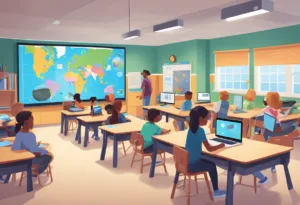
Augmented Reality (AR) offers a new way to enhance the curriculum in various subjects. It can help students visualize complex concepts, bring textbooks to life, and provide interactive learning experiences. AR can be used in various ways to enhance learning, and it is being used in many schools and universities worldwide.
Visualizing Complex Concepts
AR can be used to visualize complex concepts in subjects such as science, anatomy, and mathematics. For instance, AR can be used to create 3D models of objects that students can interact with, which can help them understand abstract concepts better. AR can also be used to create visualizations of complex systems and processes, such as the human body or the water cycle.
Augmented Textbooks and Learning Materials
AR can be used to bring textbooks and learning materials to life. For example, AR can be used to create interactive textbooks that allow students to interact with the content in new ways. AR can also be used to create learning materials that are more engaging and interactive, such as quizzes and games.
AR can also be used to provide students with hands-on learning experiences. For instance, AR can be used to create virtual labs that allow students to explore scientific concepts in a safe and controlled environment. AR can be used to create simulations that allow students to practice real-world skills, such as driving or welding.
AR can enhance the curriculum in various subjects by providing students with interactive and engaging learning experiences. AR can be used to visualize complex concepts, bring textbooks to life, and provide hands-on learning experiences. As AR technology continues to evolve, it is likely that it will become an increasingly important tool in education.
AR for Engagement and Collaboration
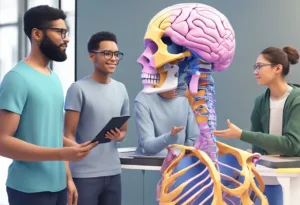
Augmented Reality (AR) is a technology that overlays digital content onto the real world, creating an interactive and engaging learning experience. AR has been shown to have a positive impact on student engagement and collaboration in the classroom. This section will explore how AR can be used to enhance student engagement and promote collaborative learning.
Enhancing Student Engagement
AR has the potential to make learning more engaging and interactive for students. By using AR, students can explore and interact with virtual objects in a way that is not possible with traditional learning methods. This can help to make learning more fun and engaging, which can lead to better learning outcomes.
AR can also be used to create immersive learning experiences that transport students to different places and times. For example, students can use AR to explore ancient ruins or visit different parts of the world without ever leaving the classroom. This can help to make learning more exciting and memorable for students.
Collaborative Learning and AR
AR can also be used to promote collaborative learning in the classroom. By using AR, students can work together to solve problems and complete tasks in a way that is not possible with traditional learning methods. This can help to promote teamwork and collaboration, which are important skills for students to develop.
AR can also be used to create shared learning experiences that promote collaboration and engagement. For example, students can use AR to collaborate on a virtual project or explore a virtual environment together. This can help to create a sense of community in the classroom and promote a shared sense of learning.
AR has the potential to revolutionize education by enhancing student engagement and promoting collaborative learning. By using AR, students can explore and interact with virtual objects in a way that is not possible with traditional learning methods. AR can also be used to create immersive learning experiences that transport students to different places and times. Furthermore, AR can be used to promote teamwork and collaboration, which are important skills for students to develop.
Future Trends and Potential of AR in Education
Emerging Technologies in Augmented Reality
As the field of augmented reality continues to grow, new technologies are emerging that could revolutionize the way we use AR in education. One such technology is spatial computing, which allows for more intuitive and interactive AR experiences by tracking the user’s movements and adjusting the virtual objects accordingly. This technology has the potential to create more immersive and engaging educational experiences, particularly in subjects like science and engineering.
Another emerging technology is the use of haptic feedback in AR, which allows users to feel virtual objects as if they were real. This technology has the potential to enhance the learning experience by providing a more tactile and sensory experience, particularly in subjects like art and design.
The Expanding Universe of Educational AR Applications
As AR technology continues to mature, the potential for educational applications is expanding rapidly. One area of particular interest is in the field of medical education, where AR can be used to create realistic simulations of medical procedures and anatomy. This has the potential to enhance the training of medical professionals and improve patient outcomes.
Another area of interest is in language education, where AR can be used to create immersive language-learning experiences. This has the potential to improve language acquisition by providing a more engaging and interactive learning environment.
The potential for AR in education is vast and exciting. Developers and researchers are continuing to push the boundaries of what is possible with this technology, and as it continues to mature, we can expect to see even more innovative and impactful applications in the years to come.
Frequently Asked Questions

How is augmented reality integrated into classroom learning experiences?
Augmented reality is integrated into classroom learning experiences by providing students with interactive and engaging tools that can be used to enhance their understanding of complex concepts. Teachers can use augmented reality apps to create interactive simulations, models, and visual aids that can be used to supplement traditional teaching methods. Augmented reality can also be used to create virtual field trips, allowing students to explore historical sites, museums, and other locations without ever leaving the classroom.
What are the benefits of using augmented reality for students and educators?
The benefits of using augmented reality for students and educators include increased engagement, improved retention of information, and enhanced critical thinking skills. Augmented reality can provide students with a more immersive learning experience that can help them better understand complex concepts. Teachers can also use augmented reality to create personalized learning experiences that are tailored to the needs of individual students.
Can you provide examples of free augmented reality applications that are beneficial for educational purposes?
Yes, there are several free augmented reality applications that are beneficial for educational purposes. Some examples include:
- Google Expeditions: A virtual reality app that allows teachers to take their students on virtual field trips to various locations around the world.
- Quiver: An augmented reality coloring app that brings coloring pages to life.
- Anatomy 4D: An augmented reality app that allows students to explore the human body in 3D.
In what ways has augmented reality influenced emerging educational trends?
Augmented reality has influenced emerging educational trends by providing students with new and innovative ways to learn. Augmented reality has the potential to transform the way that students learn by providing them with a more immersive and engaging learning experience. It has also led to the development of new teaching methods that are more interactive and personalized.
How do augmented reality and virtual reality differ in their applications within educational settings?
Augmented reality and virtual reality differ in their applications within educational settings in several ways. Augmented reality overlays digital elements onto the real world, while virtual reality creates a completely digital environment. Augmented reality is often used to supplement traditional teaching methods, while virtual reality is used to create immersive learning experiences.
What findings have been presented in research papers regarding the impact of augmented reality on education and training?
Research has shown that augmented reality can have a positive impact on education and training. Augmented reality has been shown to increase student engagement, improve retention of information, and enhance critical thinking skills. It has also been shown to be an effective tool for teaching complex concepts and providing students with personalized learning experiences.

